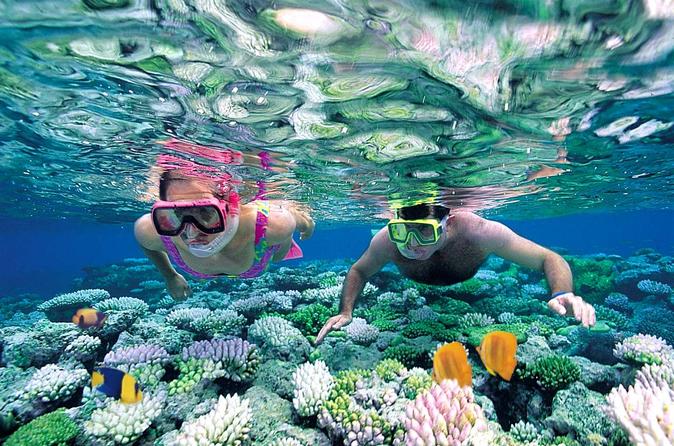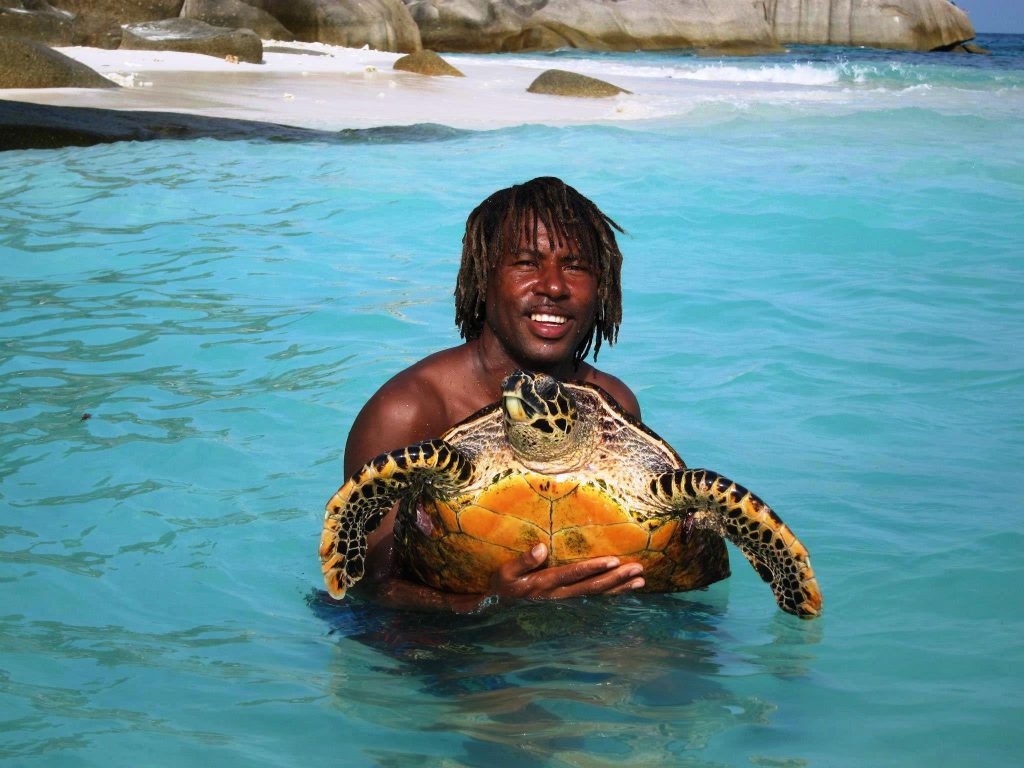The Seychelles archipelago is made up of over 115 stunning islands and islets emerging from the Indian Ocean. Each island has it own unique colourful character, however they all have one thing in common – white sandy beaches bathed by warm, crystal-clear aqua waters.
Amazingly over 50% of the Seychelles territory is classified as natural reserves, offering a safe haven for undersea creatures to flourish. This makes for some memorable snorkelling and diving opportunities.
Snorkeling in Mahe:
With many bays and coves, and several islands and isles near the coast, Mahé boasts a wide variety of snorkeling sites for all levels of ability. You can explore the shallow lagoons of bays such as Anse Royale, reef drop-offs close to shore, barrier reefs that are a little further out to sea and granitic underwater seascapes all along the coasts.
Our top picks for snorkeling in Mahe are:
Anse Royale
Fringed by a majestic reef and granitic boulders, the bay of Anse Royale offers sheltered waters ideal for swimming, snorkelling, boating, fishing, kayaking and paddle boarding. Enjoyable all year round but particularly spectacular during the North-West trade winds when the aqua-blue waters are translucent, balmy and tranquil.
The best areas for snorkelling are around the rocks at Fairyland and up to the small island just off the coast, where there are myriad brightly coloured coral fish. The water here is enclosed behind a reef, which keeps out the larger fish and is fairly shallow.
Anse Major
Anse Major is located approximately 3km west of Bel Ombre, on the northern coast of Mahé. To get there you can choose the 1 hour coastal hike through Morne Seychellois National Park (read all about the hike in our post “Hiking: Anse Major Trail“) or if you don’t want to walk, you can book a taxi boat from Bel Ombre, which will drop you off on the beach (we recommend the taxi boat “Happiness”).
The beach is not sheltered by a barrier reef so opens directly to the sea. At either end of the beach, the granite rocks and coral reefs offer excellent opportunities for snorkeling. The Anse Major reefs are well preserved and full of fish. You may come across emperor, threespot and semicircle angelfish, some of the most colourful fish species living around Mahé, plus the bluespotted grouper, green birdmouth wrasse, white-spotted boxfish, or young specimen of several species of moray eels hidden in the rocky crevices.
Anse Soleil
Anse Soleil sits on a small peninsula in the far south-western region of Mahé. Like Anse Major the beach is not sheltered by a barrier reef, so opens directly to the sea. Anse Soleil boasts varied sea beds from superb branched coral beds of fluorescent blue, sheer granite rocks and immaculate sandy sea beds.
Try to spot Seychelles three species of angelfish: the semicircle angelfish, the highly colourful emperor angelfish or the more discrete threespot angelfish, with its lemon yellow outfit. Shoals of silver moony and sergeant major fish live near the shelter of the granite rocks, while surgeonfish and wrasse dart above the coral. It is also quite common to see a spotted eagle ray venture into the bay.
A word of caution, whilst this an amazing spot to snorkel, snorkelling is not recommended here from June to October when this side of the island is exposed to strong southerly winds, making for rough sea conditions.
Sainte-Anne National Park
Ste. Anne Marine National Park was created in 1973 to protect a group of 6 islands laying only 5 kilometers from the capital city of Victoria.
Accessible only by the sea, Sainte-Anne Marine Park provides a unique concentration of underwater ecosystems. It protects coral gardens, but also one of the largest areas of sea grass meadows in the granitic bank of the Seychelles. In the warm waters surrounding the islands, snorkelers can observe a large number of fish species, including manta rays, which are regular visitors to the area from April to December.
A large number of local tour operators organise half day tours to the National Park, including 1 to 3 snorkeling stops. Most excursions to Sainte-Anne leave from Victoria and cost approximately €50 per person.
Baie Ternay & Port Launay National Park, are another two National Marine Parks which offer stunning snorkeling spots on the north-western coast of Mahé.
Snorkeling La Digue:
La Digue, Félicité and Coco are a must for any snorkelers visiting the Seychelles. Their crystal-clear waters are rich in well-preserved coral formations and blockfields that are home to exceptional underwater sea life: shoals of surgeonfish, snappers and green humphead parrotfish, angelfish, anthias, and a whole host of other species. Surprisingly tame hawksbill sea turtles can be seen very easily, as can eagle rays.
Most of the spots are not protected by a reef or rock barrier, and you will almost always be dependent on the weather and sea conditions (which fortunately are excellent most of the time) for a swim in perfect safety.
Our top picks for snorkeling in La Digue are:
Anse Source d’Argent
Anse Source d’Argent is said to be the most photographed beach in the world, and it is clear to see why photographers and film makers the world over love it so much. Boasting soft white sand, clear turquoise water and huge granite boulders sculptured by the elements, this truely is a magical place to relax, enjoy and even get married!
The beach is ideal for newcomers to snorkeling as it is sheltered by a full coral reef. Although the lagoon is shallow and there is little coral, you can still see many fish such as butterfly fish, porcupine fish, moorish idols and damselfish in the calm sheltered waters. More experienced and confident snorkelers can adventure out to the other side of the reef, when the sea conditions permit.
Read all about L’Union Estate and Anse Source d’Argent HERE and, while tempting to stop at the first crystal cove, be sure to keep walking until the last cove where the lagoon is best preserved.
Coco Island Marine Park
Not far from La Digue, the rich depths of Coco Island Marine Park offer a stunning natural aquarium – a must see for lovers of snorkeling. Around this idyllic isle bathed by crystal-clear waters, you can swim amid turtles and hundreds of fish above a wealth of colourful corals. Unless you have your own boat or are visiting the Seychelles in a catamaran, you will need to book a half-day excursion from La Digue to visit the spot – a worthwhile investment for sure.
The area to explore is at the edge of Coco Island (facing the small white sandy beach) and near the islands surrounding it. The underwater life in this spot is impressive in density and variety. Shoals of powder blue tangs, hawksbill sea turtles, spotted eagle rays, parrotfish, blue damselfish, and deep red anthias cruise amongst the well preserved coral. Sea conditions can vary here, so be sure to take care and follow your tour guide’s instructions at all times.
When is the best time to snorkel?
Thankfully snorkeling is possible all the year round, with average water temperatures of approximately 28°C. Rains are most frequent between October and March (peaking in January), however the temperatures are highest at this time (approx. 30°C) and quite humid. April to September offers a cooler and dryer period, however it is windier at this time. The inter-seasons of March to May and September to November are the best periods for snorkeling weather-wise, and lie outside the peak tourist periods of December, July and August.
So what are you waiting for, grab your mask, snorkel and flippers and get exploring!!
Ps) if you are looking to purchase snorkeling equipment before your travels, we recommend the full face masks such as the “Tribord Easybreath” which offer a small, compact, easy to use alternative to the old mask and snorkel set up. We got some of these masks for Christmas and they are just amazing (even my grandma can use them!). Some full face masks even come with GoPro fittings so that you can document your Seychelles snorkeling experiences.
Credit: www.snorkeling-report.com for snorkeling recommendations and images.









